Architectural Sculpture - Features, Context and Scholars
0.0(0)
Card Sorting
1/36
There's no tags or description
Looks like no tags are added yet.
Study Analytics
Name | Mastery | Learn | Test | Matching | Spaced |
|---|
No study sessions yet.
37 Terms
1
New cards

Pediment of the temple of Artemis at Corcyra: Centre of Pediment - Features
Aesthetics:
* Depicted facing ahead, probably running from Perseus (though he is not depicted)
* Wears a belt of two intertwined snakes (snakes show her demonic/monstrous nature)
* Snakes on either side of her hair (her depictions in art are different from in literature)
* Flanked by her children (Pegasus and Chrysaor) and two panthers (represent protection) who effectively fill the space in a crouched position
Function:
* To be an apotropaic spirit (warding off evil), in doing so she is protecting the temple
* Also, the snakes prevent malice from entering the temple
* Depicted facing ahead, probably running from Perseus (though he is not depicted)
* Wears a belt of two intertwined snakes (snakes show her demonic/monstrous nature)
* Snakes on either side of her hair (her depictions in art are different from in literature)
* Flanked by her children (Pegasus and Chrysaor) and two panthers (represent protection) who effectively fill the space in a crouched position
Function:
* To be an apotropaic spirit (warding off evil), in doing so she is protecting the temple
* Also, the snakes prevent malice from entering the temple
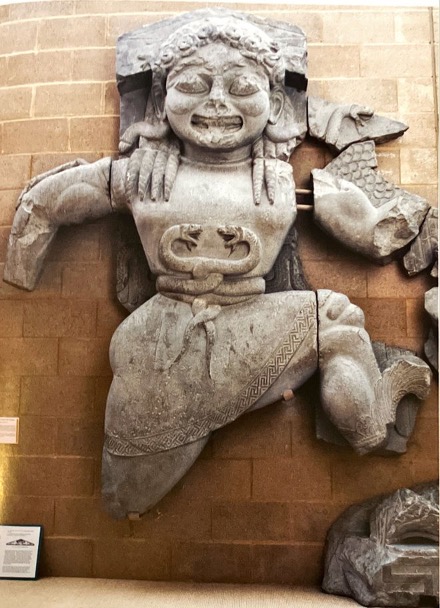
2
New cards
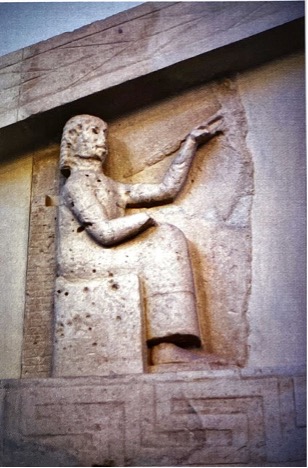
Pediment of the Temple of Artemis at Corcyra: Seated figure and Gigantomachy Battle - Features
Seated Figure:
* Has been identified as Priam (king of Troy), threatened by a spear
* Behind him is a fallen warrior
* OR Rhea OR Kronos
* The latter two would fit the theme on the other side as the gigantomachy
Gigantomachy Battle:
* Two figures fighting
* One on the right likely to be Zeus wielding a thunderbolt
* Other figure attempts to hold off the attack
* Could be scene from gigantomachy
* Has been identified as Priam (king of Troy), threatened by a spear
* Behind him is a fallen warrior
* OR Rhea OR Kronos
* The latter two would fit the theme on the other side as the gigantomachy
Gigantomachy Battle:
* Two figures fighting
* One on the right likely to be Zeus wielding a thunderbolt
* Other figure attempts to hold off the attack
* Could be scene from gigantomachy
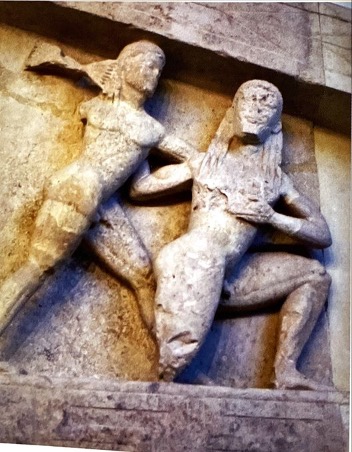
3
New cards

Pediment of the Temple of Artemis, Corcyra: Scholarly Quotes
Woodford:
* Contends figure on the right must be Zeus because only Zeus wielded the thunderbolt, and that the seated figure is Priam about to be slain by Neoptolomus at the altar (thus depicting Trojan war)
* “***No fewer than 3 stories therefore have been evoked and 2 grim beasts portrayed in this ambitious, early work***”
* “\[such\] ***niceties of logical (or chronological) consistency did not occur to artists or to spectators until considerable later times.***” –about Medusa’s children featuring besides her despite the fact she is depicted alive
\
* Contends figure on the right must be Zeus because only Zeus wielded the thunderbolt, and that the seated figure is Priam about to be slain by Neoptolomus at the altar (thus depicting Trojan war)
* “***No fewer than 3 stories therefore have been evoked and 2 grim beasts portrayed in this ambitious, early work***”
* “\[such\] ***niceties of logical (or chronological) consistency did not occur to artists or to spectators until considerable later times.***” –about Medusa’s children featuring besides her despite the fact she is depicted alive
\
4
New cards
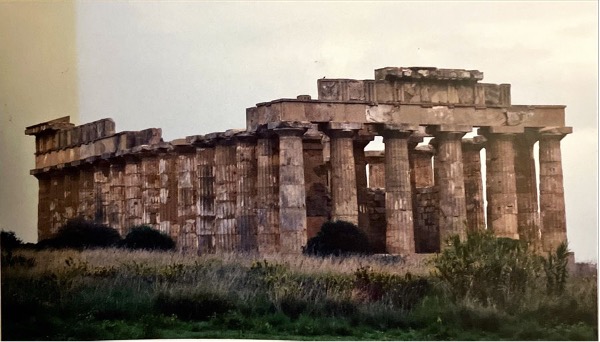
Metope of Temple C, Selinus: Myth
* Hercules is doing a year’s penance under Queen Omphale in Lydia because he killed Iphitus, son of King Eurytus
* During this time, **two kerkopes** steal his weapons while he is asleep
* When Hercules wakes up, he catches them and **hangs them upside down on a pole**
* He **carries the pole on his shoulders**, and the kerkopes were able to see his bottom
* They began to laugh, and Hercules let them go, after realising why they were laughing and finding it funny too
* During this time, **two kerkopes** steal his weapons while he is asleep
* When Hercules wakes up, he catches them and **hangs them upside down on a pole**
* He **carries the pole on his shoulders**, and the kerkopes were able to see his bottom
* They began to laugh, and Hercules let them go, after realising why they were laughing and finding it funny too
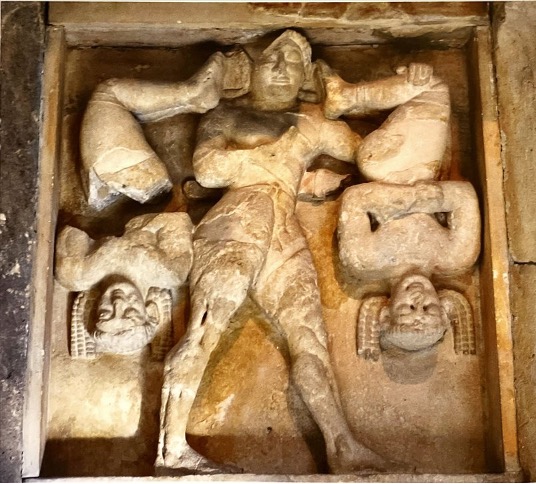
5
New cards
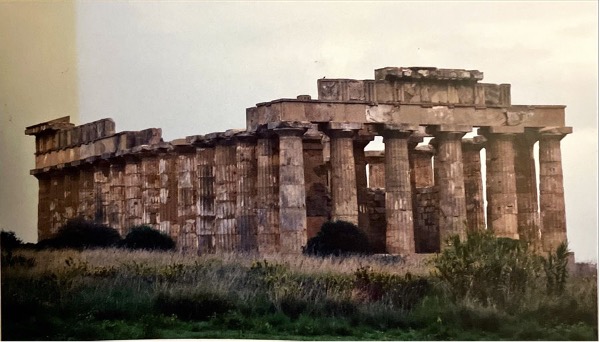
Metope of Temple C, Selinus: Key Aesthetics
Positioning:
* This metope is between two others, so Hercules’ walking motion guides the viewer to the next metope
* Metope dominated by vertical lines (hanging Kerkopes and H’s torso)
* Triangular shape of H’s legs create diversity
Similarities to Pediment of Temple of Artemis, Corcyra:
* Twisted torso with frontal face of Hercules (like Medusa)
* Framed by: Kerkopes/Panthers
* Occupation of space
* Symmetry
The Kerkopes:
* Bonds visible on ankles and arms
* Their hair, arms and faces are carefully sculpted to arrange symmetrical patterns
Archaic Features:
* H face frontal, torso side view
* Symmetrical composition
* Mirrored arrangement of Kerkopes frames central figure of Hercules
* This metope is between two others, so Hercules’ walking motion guides the viewer to the next metope
* Metope dominated by vertical lines (hanging Kerkopes and H’s torso)
* Triangular shape of H’s legs create diversity
Similarities to Pediment of Temple of Artemis, Corcyra:
* Twisted torso with frontal face of Hercules (like Medusa)
* Framed by: Kerkopes/Panthers
* Occupation of space
* Symmetry
The Kerkopes:
* Bonds visible on ankles and arms
* Their hair, arms and faces are carefully sculpted to arrange symmetrical patterns
Archaic Features:
* H face frontal, torso side view
* Symmetrical composition
* Mirrored arrangement of Kerkopes frames central figure of Hercules
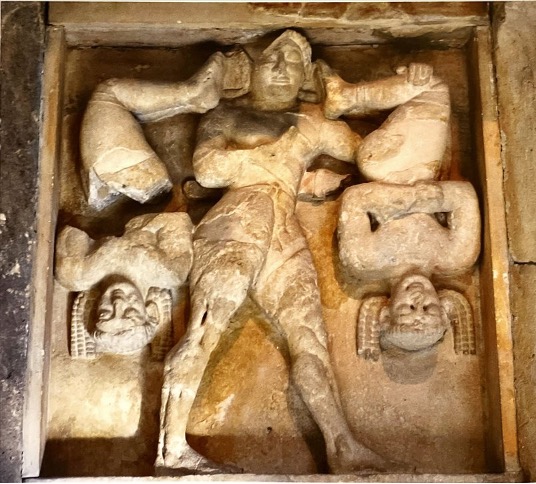
6
New cards
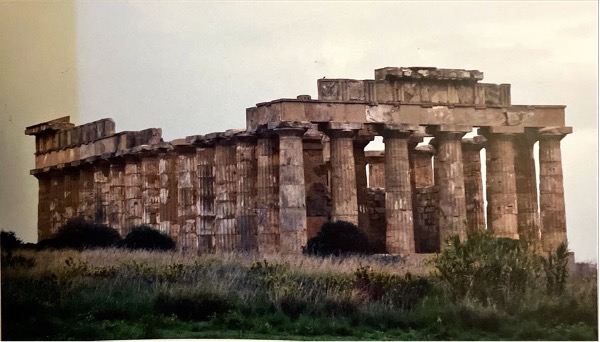
Metope of Temple C, Selinus: Scholarly Quotes
Woodford
* “***The whole well-constructed design is based on the play of symmetrical forms, both large and small***.”
* H’s striding legs provide “***enlivening diagonal accents in a composition that is otherwise dominated by emphatic verticals and horizontals.***”
* “***The whole well-constructed design is based on the play of symmetrical forms, both large and small***.”
* H’s striding legs provide “***enlivening diagonal accents in a composition that is otherwise dominated by emphatic verticals and horizontals.***”
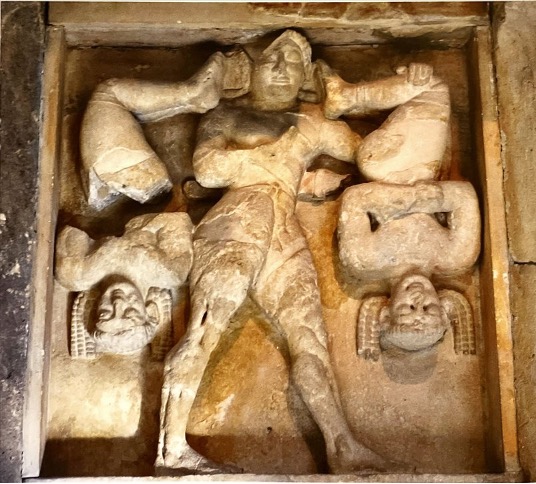
7
New cards
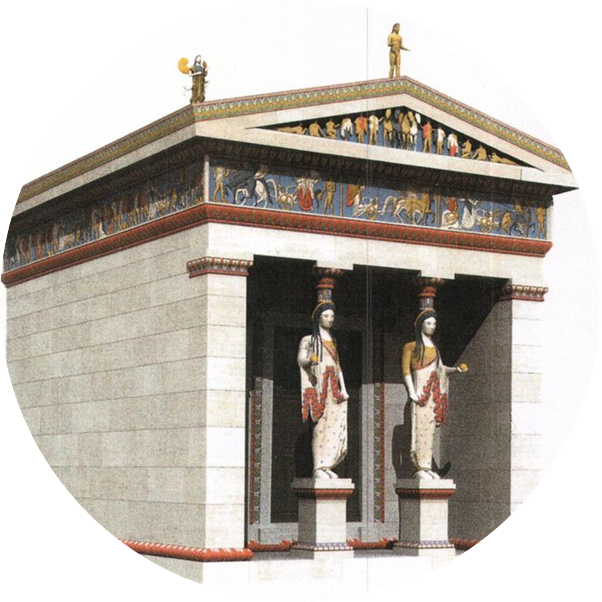
Ionic Frieze on the Siphnian treasury, Delphi:
**Built: 525BC** (Archaic)
Located: along the Sacred Way to the Temple of Apollo at Delphi
Material: First religious structure to be **made entirely of marble**
Narratives: **Gigantomachy (North), Trojan War (East), Abduction Scene (South), Judgement of Paris (West)**
* Had two Caryatids acting as columns along the front (would have been particularly eye-catching)
* On all four sides the artist has maximised the continuous frieze to show more than one aspect of the myth, **overlapping sculptural figures** to reflect the actions in each narrative
Located: along the Sacred Way to the Temple of Apollo at Delphi
Material: First religious structure to be **made entirely of marble**
Narratives: **Gigantomachy (North), Trojan War (East), Abduction Scene (South), Judgement of Paris (West)**
* Had two Caryatids acting as columns along the front (would have been particularly eye-catching)
* On all four sides the artist has maximised the continuous frieze to show more than one aspect of the myth, **overlapping sculptural figures** to reflect the actions in each narrative
8
New cards
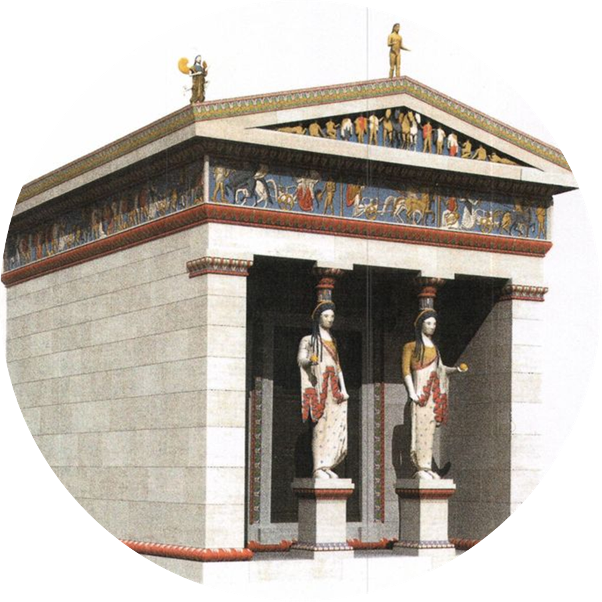
Ionic Frieze on the Siphnian treasury, Delphi: North - Gigantomachy
* **Victory of civilisation** and order over barbarity
* **Visible to pilgrims** walking up the Sacred Way to the oracle
* Perhaps not coincidental they were **faced with the story of why these gods are worshipped** instead of the Titans as they walked to consult their god Apollo
* The **giants** are shown **heavily armed** with **helmets, breastplates, shields**
* The **gods** are shown **attacking** on the left with **spears, swords and arrows**
* **Visible to pilgrims** walking up the Sacred Way to the oracle
* Perhaps not coincidental they were **faced with the story of why these gods are worshipped** instead of the Titans as they walked to consult their god Apollo
* The **giants** are shown **heavily armed** with **helmets, breastplates, shields**
* The **gods** are shown **attacking** on the left with **spears, swords and arrows**

9
New cards
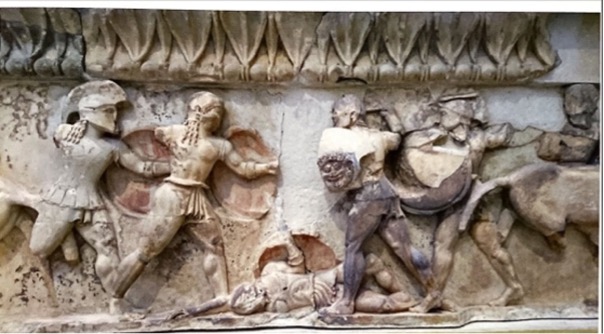
Ionic Frieze on the Siphnian treasury, Delphi: East - Trojan War
The right side:
* The mortal scene shows a group of soldiers **duelling over the body of a dead warrior**
* Achaeans are on the right with the Trojans on the left (their **long-haired helmets suggesting exoticness**)
* Achilles (identifiable as holding the shield with Medusa portrayed) stands at the front to fight Memnon
* On both sides the warriors are mid-action; Striding forward
* Each warrior **rests on the ball of their foot** and **their torsos lean forward**, ready to attack
* There are holes where bronze attachments would have been fitted, **glistening in the sunshine** to enliven the scene
The left side:
* Depicts the gods, holding an assembly
* Ares, Aphrodite, Artemis and Apollo **make gestures with their hands**, supporting the Trojans
* They sit behind Zeus
* Are all **bigger than the mortals**, while **sat** down their **heads reach the top** of the frieze
* Their size is **a symbol of their divine status** (a similar style is later used on the **Parthenon frieze)**
* The mortal scene shows a group of soldiers **duelling over the body of a dead warrior**
* Achaeans are on the right with the Trojans on the left (their **long-haired helmets suggesting exoticness**)
* Achilles (identifiable as holding the shield with Medusa portrayed) stands at the front to fight Memnon
* On both sides the warriors are mid-action; Striding forward
* Each warrior **rests on the ball of their foot** and **their torsos lean forward**, ready to attack
* There are holes where bronze attachments would have been fitted, **glistening in the sunshine** to enliven the scene
The left side:
* Depicts the gods, holding an assembly
* Ares, Aphrodite, Artemis and Apollo **make gestures with their hands**, supporting the Trojans
* They sit behind Zeus
* Are all **bigger than the mortals**, while **sat** down their **heads reach the top** of the frieze
* Their size is **a symbol of their divine status** (a similar style is later used on the **Parthenon frieze)**
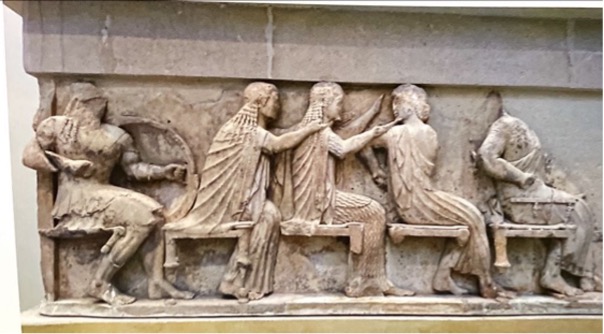
10
New cards
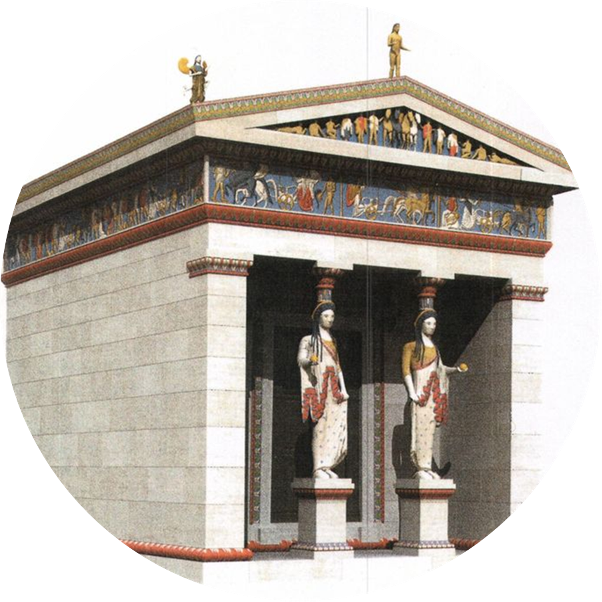
Ionic Frieze on the Siphnian treasury, Delphi: West - Judgement of Paris
* Has not survived beyond a few relief figures
* Choice of myth functions as a **nice counterpart to the east side** of the Siphnian Treasury
* This indicates that the **sculptors considered the overall effect** of the sculptural decoration
* First figure on the winged chariot is Athena, with Hermes as the Charioteer
* Aphrodite is shown stepping off her chariot (anticipating the receipt of the golden apple)
* Likely Hera was also shown on a chariot
* Choice of myth functions as a **nice counterpart to the east side** of the Siphnian Treasury
* This indicates that the **sculptors considered the overall effect** of the sculptural decoration
* First figure on the winged chariot is Athena, with Hermes as the Charioteer
* Aphrodite is shown stepping off her chariot (anticipating the receipt of the golden apple)
* Likely Hera was also shown on a chariot

11
New cards
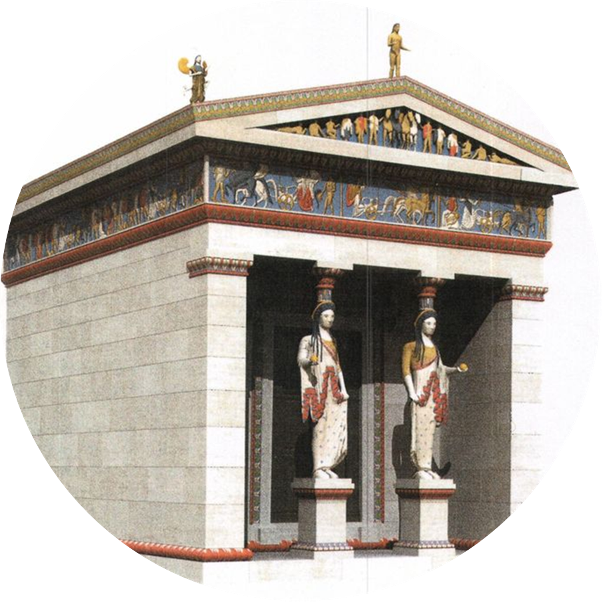
Ionic Frieze on the Siphnian treasury, Delphi: South - Abduction Scene
* An abduction scene
* The majority of the scene is missing but the **surviving fragments depict lively horses**
* The abduction of Persephone by Hades into the Underworld
* OR the abduction of Helen by Thesus
* The majority of the scene is missing but the **surviving fragments depict lively horses**
* The abduction of Persephone by Hades into the Underworld
* OR the abduction of Helen by Thesus

12
New cards
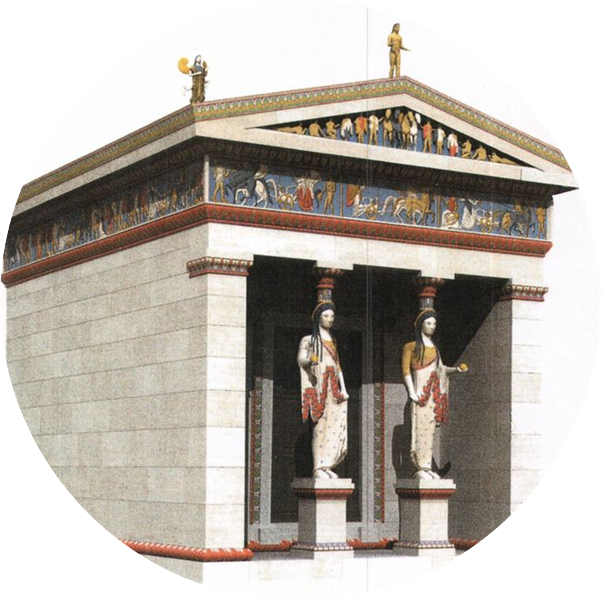
Ionic Frieze on the Siphnian Treasury, Delphi: Scholarly Quotes
Kleiner:
* An ‘***iconic***’ frieze
* Use of different material for weapons would have been ‘***dazzling***’
Barring:
* Instead of having the horses in profile, the sculptor has spread them out in graduating views with their faces looking in different directions, gradually turning towards the viewer, as if coming to the viewer at a 3/4 degree angle- adds dynamism and unusual for the archaic period, the kind of spacial illusionism being typically associated with the classical period.
\
* An ‘***iconic***’ frieze
* Use of different material for weapons would have been ‘***dazzling***’
Barring:
* Instead of having the horses in profile, the sculptor has spread them out in graduating views with their faces looking in different directions, gradually turning towards the viewer, as if coming to the viewer at a 3/4 degree angle- adds dynamism and unusual for the archaic period, the kind of spacial illusionism being typically associated with the classical period.
\
13
New cards
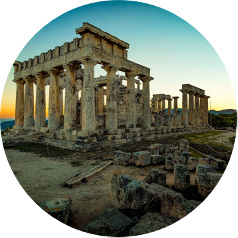
Pediments of the Temple of Aphaia, Aegina: Context
The first temple was built **570BC** (Early Archaic)
Both pediments are **united by a common narrative**: the sacking of Troy
* The **West** depicts it **as described in Homer’s Iliad** (with Paris and Ajax)
* The **East** shows the **earlier sacking of Troy by Herakles**
Not an uncommon myth as already depicted on the **Siphnian treasury** and later on the **Parthenon**
* The myth chosen as **a political statement** to claim local heroes Ajax and Telamon
In late Archaic and Early Classical times, Aegina was one of the most prosperous city-states
* In this period there was great competition between city-states, particularly Aegina and Athens as neighbouring cities
* Both claimed Ajax and Telamon as their local heroes
Both pediments are **united by a common narrative**: the sacking of Troy
* The **West** depicts it **as described in Homer’s Iliad** (with Paris and Ajax)
* The **East** shows the **earlier sacking of Troy by Herakles**
Not an uncommon myth as already depicted on the **Siphnian treasury** and later on the **Parthenon**
* The myth chosen as **a political statement** to claim local heroes Ajax and Telamon
In late Archaic and Early Classical times, Aegina was one of the most prosperous city-states
* In this period there was great competition between city-states, particularly Aegina and Athens as neighbouring cities
* Both claimed Ajax and Telamon as their local heroes
14
New cards

Pediments of the Temple of Aphaia, Aegina: West - Sacking of Troy
* The **central apex is occupied by Athena** with a **bronze spear**, maker her more imposing and powerful as **it glistened in the sun**
* She stands frontally, though her legs are sideways, wearing a thick peplos and her aegis**, armed** with a helmet, spear and shield
* **she presides ove**r but **does not engage**, with no gestures towards the chaotic fighting unfolding around her
* The **fighting is arranged outwards** around Athena
* The soldiers next to Athena have their **backs towards her**, separating her further from their engagements.
* the sculptors utilised the awkward triangular shape to showcase a **variety of poses** and a **series of mini-conflicts and engagements without repetition**
\
* Archer on the left of the pediment is identified as **Paris** because of his role as an **archer** and **eastern clothing**
* He is in a **mid action pose,** about to fire an arrow
* He is **bent down on his right knee** (filling the space) and looks ahead at his target, **resting delicately on the heel** of his left foot and the knee of his right
* Unlike other warriors he wears **long-sleeved and long-legged clothing** (others naked) painted with **bright colours**
* It captures Paris as **slightly effeminate** as common **contemporary attitude to easterners**
* He **skill as an archer** is perhaps praised, and the **fallen warriors** on the left side of the pediment could be **his victims**
\
* The surviving figure immediately to the left of Paris appears to just have been hit, holding himself up while the furthermost figure is dying
* He is very reflective of the Archaic style; his face holds the typical Archaic style at odds with death (the **Archaic smile**)
* His **folded legs appear almost casual** as a further contrast to his state (his right leg is bent as the knee, folded over his lying left leg)
* She stands frontally, though her legs are sideways, wearing a thick peplos and her aegis**, armed** with a helmet, spear and shield
* **she presides ove**r but **does not engage**, with no gestures towards the chaotic fighting unfolding around her
* The **fighting is arranged outwards** around Athena
* The soldiers next to Athena have their **backs towards her**, separating her further from their engagements.
* the sculptors utilised the awkward triangular shape to showcase a **variety of poses** and a **series of mini-conflicts and engagements without repetition**
\
* Archer on the left of the pediment is identified as **Paris** because of his role as an **archer** and **eastern clothing**
* He is in a **mid action pose,** about to fire an arrow
* He is **bent down on his right knee** (filling the space) and looks ahead at his target, **resting delicately on the heel** of his left foot and the knee of his right
* Unlike other warriors he wears **long-sleeved and long-legged clothing** (others naked) painted with **bright colours**
* It captures Paris as **slightly effeminate** as common **contemporary attitude to easterners**
* He **skill as an archer** is perhaps praised, and the **fallen warriors** on the left side of the pediment could be **his victims**
\
* The surviving figure immediately to the left of Paris appears to just have been hit, holding himself up while the furthermost figure is dying
* He is very reflective of the Archaic style; his face holds the typical Archaic style at odds with death (the **Archaic smile**)
* His **folded legs appear almost casual** as a further contrast to his state (his right leg is bent as the knee, folded over his lying left leg)
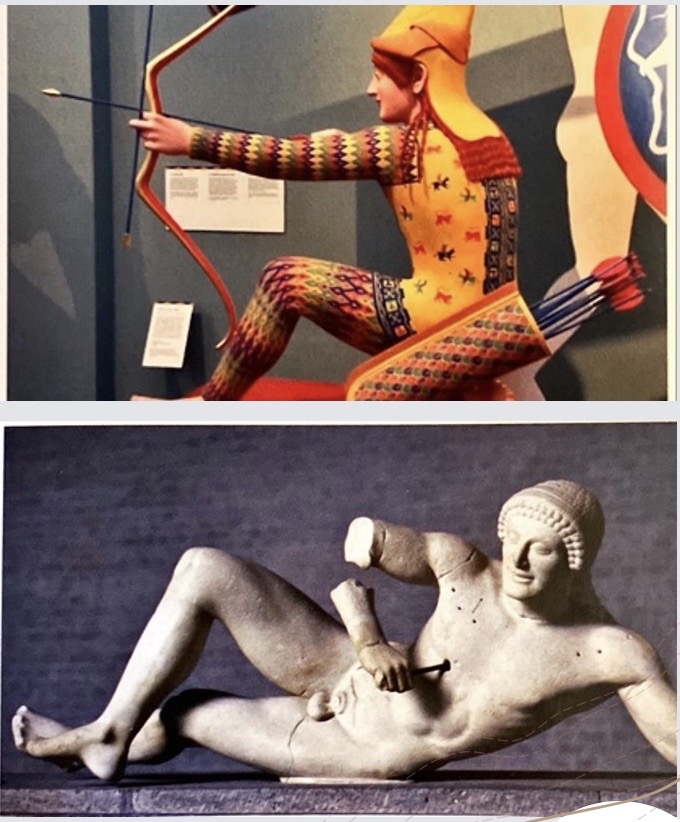
15
New cards
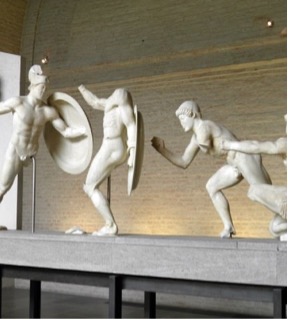
Pediments of the Temple of Aphaia, Aegina: East - Earlier Destruction of Troy
* Depicts the **earlier destruction of Troy** by Herakles and Telamon
* At first glance appears **very similar** to the West pediment
* **Athena still occupies the central space** but is far **more engaged** with the ongoing battle
* The surviving fragments suggest the **action faces inwards towards Athena (**emphasising her **relevance** and **importance**)
\
* The archer on the east pediment is **Herakles**, identified by his **lion-skin head-dress**
* He **crouches** down, **taking aim, similar to Paris** but his pose is different, reflecting his superiority
* He is **twisted slightly outwards** and **appears at an angle** from the viewer
* His **extended arm is entirely straight**, level with his shoulder, **fully focused** on his target
\
* The fallen warrior on the left corner is similarly comparable to the west but here the **warrior’s pose fully demonstrates pain and suffering** as he dies
* He lies on his side, one **leg extended**, the other bent, left arms **still in the strap of his shield** as he faces forward **looking towards the ground** and his death
* These details fill the onlooker with **pathos**, and we feel **great sympathy** for this victim
* Other sculptures in the pediments boast the glory one can win in battle, this figure **demonstrates the cost and suffering (War is considered from a number of angles)**
\
* At first glance appears **very similar** to the West pediment
* **Athena still occupies the central space** but is far **more engaged** with the ongoing battle
* The surviving fragments suggest the **action faces inwards towards Athena (**emphasising her **relevance** and **importance**)
\
* The archer on the east pediment is **Herakles**, identified by his **lion-skin head-dress**
* He **crouches** down, **taking aim, similar to Paris** but his pose is different, reflecting his superiority
* He is **twisted slightly outwards** and **appears at an angle** from the viewer
* His **extended arm is entirely straight**, level with his shoulder, **fully focused** on his target
\
* The fallen warrior on the left corner is similarly comparable to the west but here the **warrior’s pose fully demonstrates pain and suffering** as he dies
* He lies on his side, one **leg extended**, the other bent, left arms **still in the strap of his shield** as he faces forward **looking towards the ground** and his death
* These details fill the onlooker with **pathos**, and we feel **great sympathy** for this victim
* Other sculptures in the pediments boast the glory one can win in battle, this figure **demonstrates the cost and suffering (War is considered from a number of angles)**
\
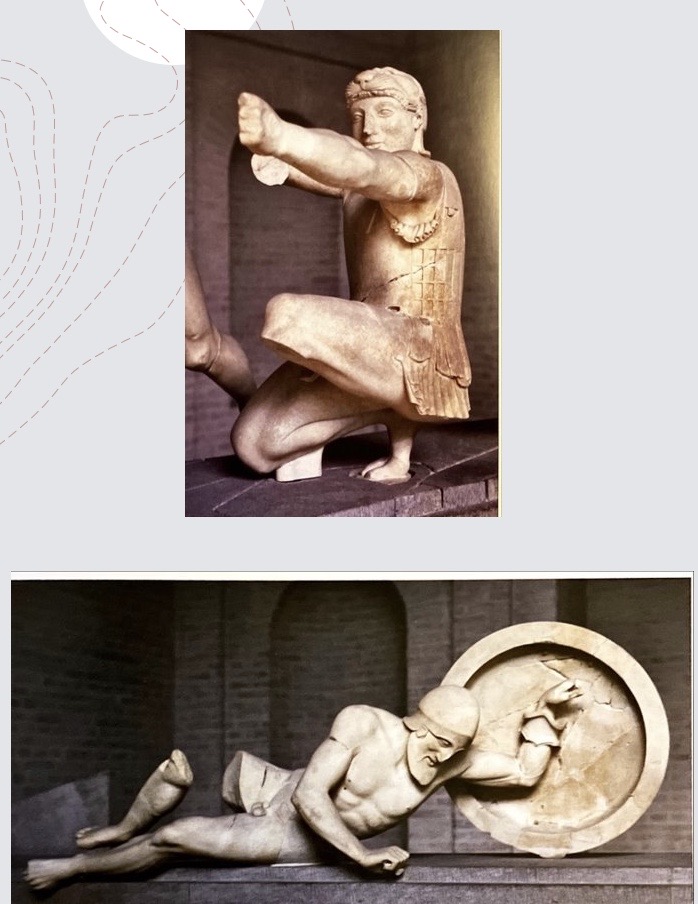
16
New cards
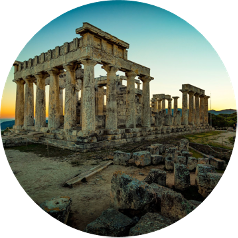
Pediments of the Temple of Aphaia, Aegina: Scholarly Quotes
Kleiner:
* (west pediment dying warrior) ‘***No sense of a thinking and feeling human being***,’
M. Norris:
* '***Monumental sculpture was slow to break free from archaic conventions of symmetry and bold frontality***'
* (west pediment dying warrior) ‘***No sense of a thinking and feeling human being***,’
M. Norris:
* '***Monumental sculpture was slow to break free from archaic conventions of symmetry and bold frontality***'
17
New cards
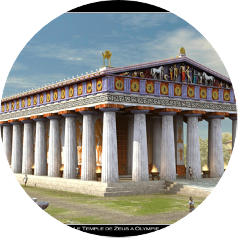
Pediments of the Temple of Zeus at Olympia: Context
* Construction from the spoils of war between Elis and Pisa around 470BC
* Temple was **completed 457BC** – when golden tripod was put on the peak of its gable dedicated by the Spartans (Early Classical period)
* **Architect was a local man named Libon** who designed the structure in the **Doric style**
* Inside was a **Chryselephantine statue of Zeus** made by Pheidias
* Temple was **completed 457BC** – when golden tripod was put on the peak of its gable dedicated by the Spartans (Early Classical period)
* **Architect was a local man named Libon** who designed the structure in the **Doric style**
* Inside was a **Chryselephantine statue of Zeus** made by Pheidias

18
New cards

Pediments of the Temple of Zeus at Olympia: East - Contest between Pelops and Oinamaos
**Date: 460BC**
Material: marble
The scene is **intense without any action**
* **almost mirror-image** composition except **Zeus**
* Each half has chariot team with servants and grooms, a seer, and a reclining figure representing one of the local rivers (Kladeos or Alpheios)
* **Zeus in middle oversees events,** protagonists of myth on either side of him
* Oinomaos stands to the right of Zeus, with a **beard** of maturity, his mouth open (maybe speaking?) making him the only active member of the still tableaux
* Pelops stands on the left of Zeus, contrasting with Oinomaos as **he is a young nude wearing only a helmet (shows off physical strength)**
* Sterope, Oinomaos’ wife, **holds head in hand** and her other arm is crossed in front of chest, **pose is inward and closed** - **sorrow** → **grieving forthcoming death** of her husband (gestures typically seen in grave reliefs)
* Hippodameia - **typical bridal gesture**, **adjusting her veil, open body language** hints towards her future marriage with Pelops
* Oinomaos’ hand **confidently placed on his right hip** and Pelop’s **head bowed** reflecting **modest character vs the arrogance** of Oinomaos (indicative of their fates: the haughty is overcome by the modest)
* Zeus’ physical strength, revealed by his bare torso, would have been impressive as the **figure was over 3m tall**
* The principal figures are flanked by two chariots, horses’ heads turned towards the center → help create context for the myth
\
* Servants sit or kneel in front or behind the horses
* **the servants are indifferent**: servant-boy **plays with his toes** as he waits for the race to begin → creates realistic **contrast between the figures involved and those who are merely bystanders**
* crouched and lying figures **fit in awkward triangular shape**
* On the right side sits an old man/a **seer** (has a **belly**, a **saggy chest**, is **balding** and has **frown lines** on forehead and a **beard**), unlike other sculpture, where **age was shown by a beard**
* His **lips are slightly parted** → **gives life** to sculpture as if he **breathes**
* fist is closed and rests on his cheek, in a **grieving pose** (maybe he sees the future and mourns for the death of Oinomaos like Sterope)
\
* The sculptors have **filled the awkward space** with **two local rivers** of Olympia: the Alphaeios and Kladeios
* Both are lying on their sides with waits covered by **thin drapery** where its **folds mimic the ripples in the river**
* They are highly **muscular**, **youthful bodes**, suggesting the **abundanc**e and **strength** of the Olympian landscape
* Their presence **locates the events of the myth** in Olympia (appropriate as chariot races were held as part of the Olympic games)
* **anatomy, movement and facial features** have developed since Archaic period: the **muscles** on figures (such as Oinomaos and Pelops) rendered by **gentle modelled lines**
* Although still schematic, lines have **not been carved so strongly and definitively** = **more naturalistic** depiction of musculature
* This is **not true for all** sculptures - the **personified rivers feature highly exaggerated musculature and rib cages.** their **rotations are still unnatural**, but **clear progression from fallen warriors at Aphaia**
* **Archaic smile is now gone**, instead figures have **mouths slightly parted** as though **breathing**
* almond-shaped eyes are also no longer there but now **thick eyelids** indicate the **Severe** **Style** (transitionary period between Archaic and Classicsal), best seen in the seer
Material: marble
The scene is **intense without any action**
* **almost mirror-image** composition except **Zeus**
* Each half has chariot team with servants and grooms, a seer, and a reclining figure representing one of the local rivers (Kladeos or Alpheios)
* **Zeus in middle oversees events,** protagonists of myth on either side of him
* Oinomaos stands to the right of Zeus, with a **beard** of maturity, his mouth open (maybe speaking?) making him the only active member of the still tableaux
* Pelops stands on the left of Zeus, contrasting with Oinomaos as **he is a young nude wearing only a helmet (shows off physical strength)**
* Sterope, Oinomaos’ wife, **holds head in hand** and her other arm is crossed in front of chest, **pose is inward and closed** - **sorrow** → **grieving forthcoming death** of her husband (gestures typically seen in grave reliefs)
* Hippodameia - **typical bridal gesture**, **adjusting her veil, open body language** hints towards her future marriage with Pelops
* Oinomaos’ hand **confidently placed on his right hip** and Pelop’s **head bowed** reflecting **modest character vs the arrogance** of Oinomaos (indicative of their fates: the haughty is overcome by the modest)
* Zeus’ physical strength, revealed by his bare torso, would have been impressive as the **figure was over 3m tall**
* The principal figures are flanked by two chariots, horses’ heads turned towards the center → help create context for the myth
\
* Servants sit or kneel in front or behind the horses
* **the servants are indifferent**: servant-boy **plays with his toes** as he waits for the race to begin → creates realistic **contrast between the figures involved and those who are merely bystanders**
* crouched and lying figures **fit in awkward triangular shape**
* On the right side sits an old man/a **seer** (has a **belly**, a **saggy chest**, is **balding** and has **frown lines** on forehead and a **beard**), unlike other sculpture, where **age was shown by a beard**
* His **lips are slightly parted** → **gives life** to sculpture as if he **breathes**
* fist is closed and rests on his cheek, in a **grieving pose** (maybe he sees the future and mourns for the death of Oinomaos like Sterope)
\
* The sculptors have **filled the awkward space** with **two local rivers** of Olympia: the Alphaeios and Kladeios
* Both are lying on their sides with waits covered by **thin drapery** where its **folds mimic the ripples in the river**
* They are highly **muscular**, **youthful bodes**, suggesting the **abundanc**e and **strength** of the Olympian landscape
* Their presence **locates the events of the myth** in Olympia (appropriate as chariot races were held as part of the Olympic games)
* **anatomy, movement and facial features** have developed since Archaic period: the **muscles** on figures (such as Oinomaos and Pelops) rendered by **gentle modelled lines**
* Although still schematic, lines have **not been carved so strongly and definitively** = **more naturalistic** depiction of musculature
* This is **not true for all** sculptures - the **personified rivers feature highly exaggerated musculature and rib cages.** their **rotations are still unnatural**, but **clear progression from fallen warriors at Aphaia**
* **Archaic smile is now gone**, instead figures have **mouths slightly parted** as though **breathing**
* almond-shaped eyes are also no longer there but now **thick eyelids** indicate the **Severe** **Style** (transitionary period between Archaic and Classicsal), best seen in the seer

19
New cards

Pediments of the Temple of Zeus at Olympia: West - Centauromachy
* battle between Centaurs and Lapiths
* In the centre **Apollo** (god of order and justice) **presides over events**, standing frontally except for extended right arm and head facing right
* **his arm forms a ninety-degree angle** with body → **occupies greater space** on the pediment
* His neat, simple and static pose **= the calmness and order** Apollo will provide, **vs brutality** of scene around him
* Unlike East, **the West pediment is filled with action,** **figures overlap and interact** with one another
\
* **movement is horizontal** rather than vertical like the East Pediment
* Centaurs **characterised as disorderly and uncivilised** through their **attack on women** and their **wild hair** and **beast-like faces**
* narrative expressed through physical contact, figures are attacking and defending, also in the **anguish shown in some of their faces**
* While numerous still have vacant expressions **some begin to show pain in their faces and body language**
* **Example:** the centaurs face where his open mouth might suggest him screaming in anguish as the woman grabs his head and punches his chin
\
* In the centre **Apollo** (god of order and justice) **presides over events**, standing frontally except for extended right arm and head facing right
* **his arm forms a ninety-degree angle** with body → **occupies greater space** on the pediment
* His neat, simple and static pose **= the calmness and order** Apollo will provide, **vs brutality** of scene around him
* Unlike East, **the West pediment is filled with action,** **figures overlap and interact** with one another
\
* **movement is horizontal** rather than vertical like the East Pediment
* Centaurs **characterised as disorderly and uncivilised** through their **attack on women** and their **wild hair** and **beast-like faces**
* narrative expressed through physical contact, figures are attacking and defending, also in the **anguish shown in some of their faces**
* While numerous still have vacant expressions **some begin to show pain in their faces and body language**
* **Example:** the centaurs face where his open mouth might suggest him screaming in anguish as the woman grabs his head and punches his chin
\
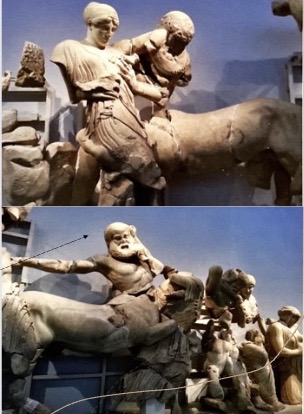
20
New cards
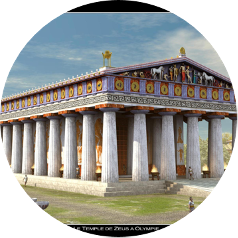
Metopes of the Temple of Zeus at Olympia: Context
* Above the East and West porches of the temple were **6 sculpted metopes** depicting the **12 labours of Herakles**
* Herakles **exemplified the ideal athlete** (determination courage and self-discipline)
* His labours were **symbolic of civilisation over chaos and barbarity** as he rid the world of monsters
\
* **Date: 460BC**
* **Material: marble**
* Herakles **exemplified the ideal athlete** (determination courage and self-discipline)
* His labours were **symbolic of civilisation over chaos and barbarity** as he rid the world of monsters
\
* **Date: 460BC**
* **Material: marble**
21
New cards
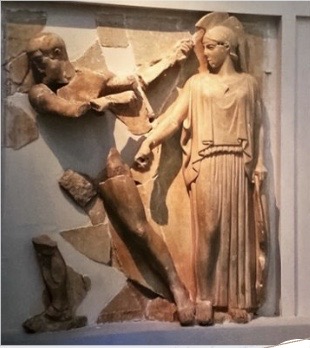
Metopes of the Temple of Zeus at Olympia: Heracles and the Stables of Augeas
* Metope depicts **Herakles mid-cleaning** the dung with Athena behind him, supporting and guiding him.
* **Victory of intelligence** → Athene’s presence
* **Athena stands frontally** but her head and right arm focus on Herakles and his task
* Besides her helmet **she wears no armour**
* her gesture and **everyday clothing (peplos) present her as supportive and approachable,** not the same military goddess as on the pediments at Aphaia
* Her **power is still evident** through her **calm** stance and presence
* **Her vertical lines contrast with Herakles’ diagonal action**; while he struggles with his whole body to carry out a task, she stands serenely in control of the situation
* similar the contrasting poses and action we saw on the west pediment
* **Herakles appears bearded**, showing his mature age
\
* **Victory of intelligence** → Athene’s presence
* **Athena stands frontally** but her head and right arm focus on Herakles and his task
* Besides her helmet **she wears no armour**
* her gesture and **everyday clothing (peplos) present her as supportive and approachable,** not the same military goddess as on the pediments at Aphaia
* Her **power is still evident** through her **calm** stance and presence
* **Her vertical lines contrast with Herakles’ diagonal action**; while he struggles with his whole body to carry out a task, she stands serenely in control of the situation
* similar the contrasting poses and action we saw on the west pediment
* **Herakles appears bearded**, showing his mature age
\
22
New cards
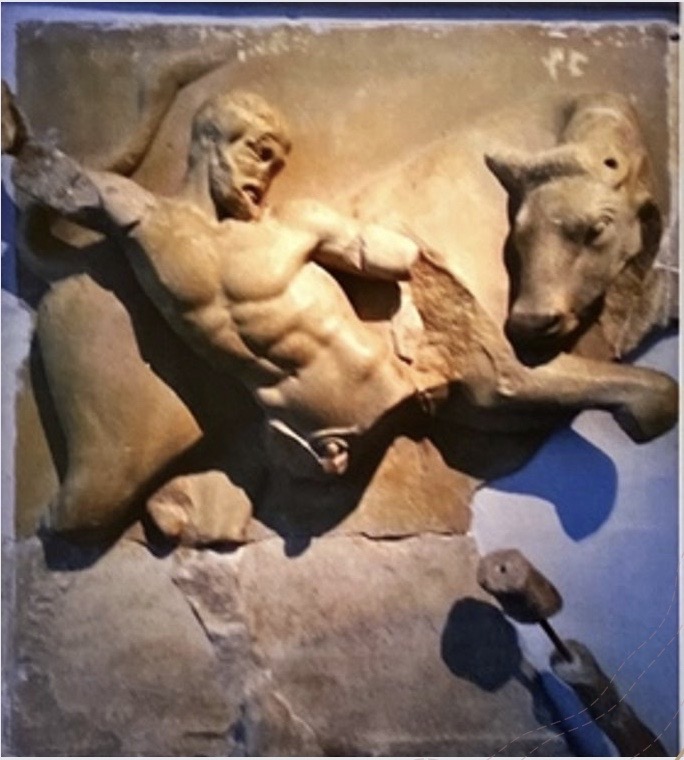
Metopes of the Temple of Zeus at Olympia: Heracles and the Cretan Bull
* the Cretan bull was destroying agriculture
* In capturing the bull, Herakles was **bringing civilisation by ridding the area of a monster**
* Composition consists of **two diagonal lines** as Herakles and the bull cross one another. Herakles leans to the left, resting his weight on his bent right leg and lunging to the side, pulling the bull’s head round so that beast and man confront each other, and their eyes bring the focus into the centre of the metope
* bull probably rested on back feet with front two in the air making the scene **more dramatic and active**
* **X-shape formed** by two bodies creates powerful composition as contestants strain away from one another. The dynamic design **reflects difficulty of the task**.
* sculptor **filled the whole space**, using the **bull’s tail to occupy top left** corner
* Herakles depicted as mature **with a beard** as well as his developed musculature, portraying **mature physical strength rather than youth**
* In capturing the bull, Herakles was **bringing civilisation by ridding the area of a monster**
* Composition consists of **two diagonal lines** as Herakles and the bull cross one another. Herakles leans to the left, resting his weight on his bent right leg and lunging to the side, pulling the bull’s head round so that beast and man confront each other, and their eyes bring the focus into the centre of the metope
* bull probably rested on back feet with front two in the air making the scene **more dramatic and active**
* **X-shape formed** by two bodies creates powerful composition as contestants strain away from one another. The dynamic design **reflects difficulty of the task**.
* sculptor **filled the whole space**, using the **bull’s tail to occupy top left** corner
* Herakles depicted as mature **with a beard** as well as his developed musculature, portraying **mature physical strength rather than youth**
23
New cards
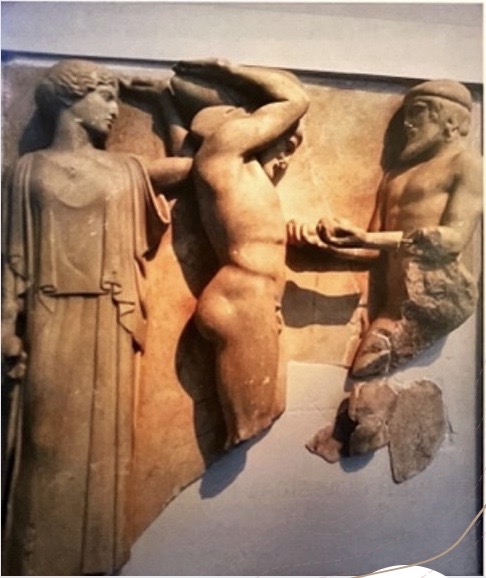
Metopes of the Temple of Zeus at Olympia: Herakles and the Garden of Hesperides
* Herakles in the **centre**, **carrying world** on his shoulders, while Atlas presents the apples to him.
* Athena **stands frontally** behind Herakles, with only her head and left arm turned to the side. Left hand raised above her head supports Herakles, her calm expression makes it seem effortless and emphasises power and divinity
* Composition of this metope **is vertical**, the three figures stand upright
* Herakles is **side profile**, but Atlas is in **three-quarter view**
* Each figure is depicted in a **subtly different** way, avoiding repetition and **individualising** them
* Unlike previous two metopes, **his action is not of dynamic movement** and strength but **instead shows great concentration and focus**
* the sculptors evidently focused on the individual narratives and wanted **variety in the metopes**
* Atlas is depicted on the far right with outstretched arms, occupying the most space on the metope
* apples would have been **likely made of bronze**, standing out against the painted marble → **reflecting** **the divine nature of the objects**
* Athena **stands frontally** behind Herakles, with only her head and left arm turned to the side. Left hand raised above her head supports Herakles, her calm expression makes it seem effortless and emphasises power and divinity
* Composition of this metope **is vertical**, the three figures stand upright
* Herakles is **side profile**, but Atlas is in **three-quarter view**
* Each figure is depicted in a **subtly different** way, avoiding repetition and **individualising** them
* Unlike previous two metopes, **his action is not of dynamic movement** and strength but **instead shows great concentration and focus**
* the sculptors evidently focused on the individual narratives and wanted **variety in the metopes**
* Atlas is depicted on the far right with outstretched arms, occupying the most space on the metope
* apples would have been **likely made of bronze**, standing out against the painted marble → **reflecting** **the divine nature of the objects**
24
New cards

Temple of Zeus at Olympia: Scholarly Quotes
Pausanias:
* ‘***The Parthenon was not as interesting as the Temple of Zeus***,’
Osborne:
* The metopes show ‘***man's ability to overcome monstrous challenges and win through,***’
* (The impact of the Seer on the East Pediment of the Temple of Zeus at Olympia) – ‘***A moment of new mental clarity***,’
Woodford:
* (east pediment) ‘***Intense but wholly without action***,’
Kleiner:
* ‘\[The metopes\] ***contrast the smiling/elaborately clad figures of the late Archaic period,***’
* ‘***The Parthenon was not as interesting as the Temple of Zeus***,’
Osborne:
* The metopes show ‘***man's ability to overcome monstrous challenges and win through,***’
* (The impact of the Seer on the East Pediment of the Temple of Zeus at Olympia) – ‘***A moment of new mental clarity***,’
Woodford:
* (east pediment) ‘***Intense but wholly without action***,’
Kleiner:
* ‘\[The metopes\] ***contrast the smiling/elaborately clad figures of the late Archaic period,***’
25
New cards
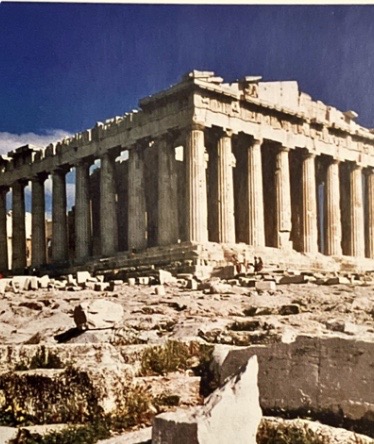
Partenon - Context
* The Parthenon was dedicated to Athena Parthenos (Athena the virgin or Athena the maiden)
* It was set up on the acropolis of Athens
* The acropolis already had a number of religious buildings built on it before the Parthenon was established
* The Parthenon was the largest temple on the Greek mainland at the time
* It was set up on the acropolis of Athens
* The acropolis already had a number of religious buildings built on it before the Parthenon was established
* The Parthenon was the largest temple on the Greek mainland at the time
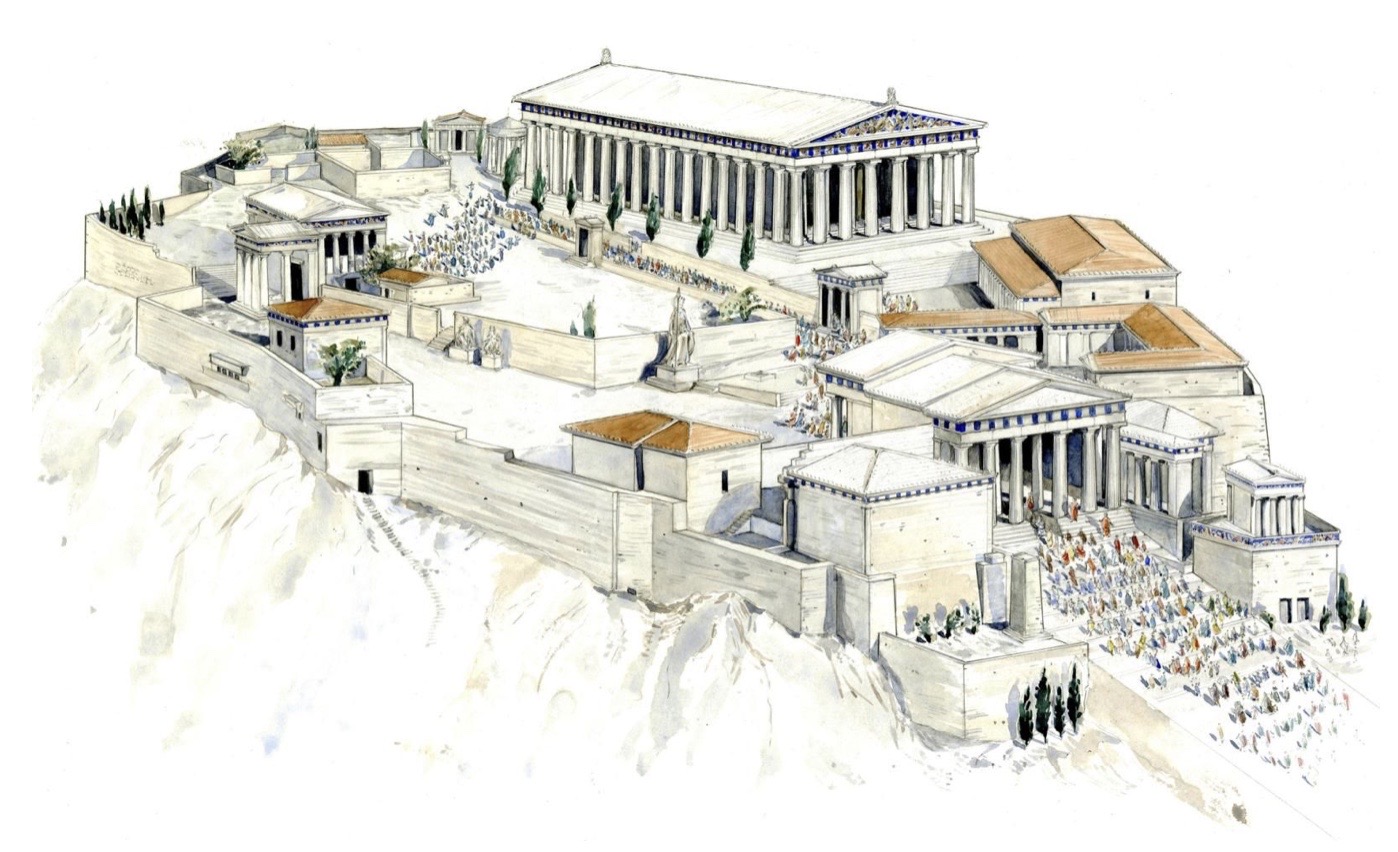
26
New cards
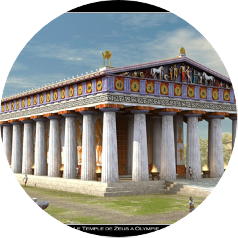
Parthenon - Architecture
* It was the first time that the Doric and ionic orders were mixed so much
* It was the first time a temple had been built entirely of marble
* It housed more architectural sculpture than any other temple
* Both of the pediments were sculpted
* All the four sides of the temple were decorated with sculpted metopes
* An ionic frieze ran along the four sides of the cella wall
* Cella was the inner chamber of the temple
* It was the first time a temple had been built entirely of marble
* It housed more architectural sculpture than any other temple
* Both of the pediments were sculpted
* All the four sides of the temple were decorated with sculpted metopes
* An ionic frieze ran along the four sides of the cella wall
* Cella was the inner chamber of the temple
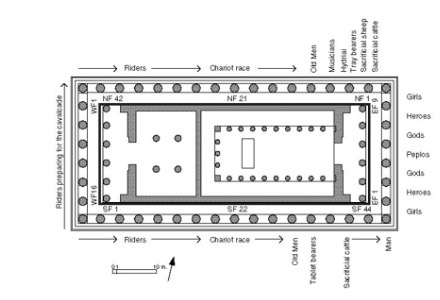
27
New cards
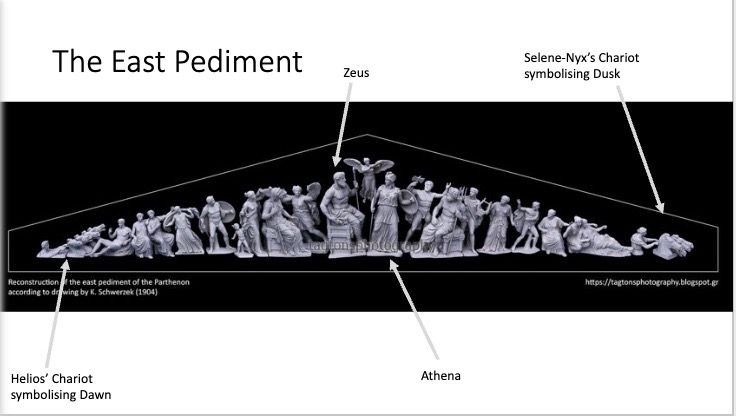
Parthenon - East Pediment and the Three Goddesses
* The East pediment shows the birth of Athena who is the patriot god of Athens
* According to the myth Athena was born fully grown and fully armed for the head of her father Zeus
\
Three Goddesses on the right:
* The three goddesses on the right are likewise shown to be at ease resting on the lap on another showing great intimacy and familiarity
* These mirrored reclining figures contrast both in their use of drapery and in their interaction with other figures
* The figures are not looking at the events at the centre of the pediment however, perhaps suggesting that the news of Athena’s birth has not yet reached them
* It is possible that the sculptors did not know how to fill the awkward triangular shape to bring the narrative together
* According to the myth Athena was born fully grown and fully armed for the head of her father Zeus
\
Three Goddesses on the right:
* The three goddesses on the right are likewise shown to be at ease resting on the lap on another showing great intimacy and familiarity
* These mirrored reclining figures contrast both in their use of drapery and in their interaction with other figures
* The figures are not looking at the events at the centre of the pediment however, perhaps suggesting that the news of Athena’s birth has not yet reached them
* It is possible that the sculptors did not know how to fill the awkward triangular shape to bring the narrative together
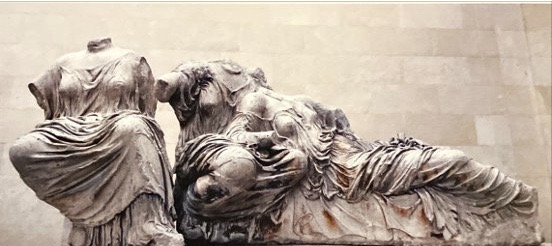
28
New cards
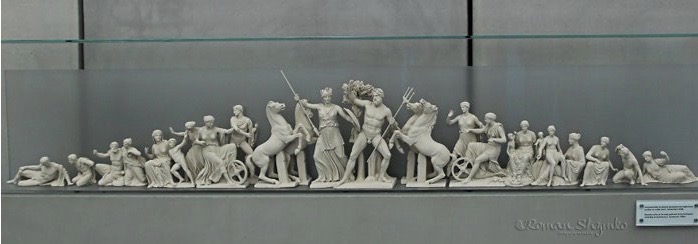
Parthenon - West Pediment
* Dates from 437 to 432 BC
* The west Pediment depicts the contest between Athena and Poseidon over the patronage of the city now known as Athens
* The majority of the sculptures from the Pediments are lost
* The two central figures which are only fragmentary were probably striding away from each other but turning to look back
* Poseidon’s torso survives however and it gives a very good indicator of how he was portrayed
River in the left corner:
* In the left corner of the west pediment the Ilissos River is personified
* As with the east pediment on the Temple of Zeus at Olympia which locates the events of the myth
* The OCR textbook argues that there is development in the treatment of the body
* It asserts the sculptor here depicts a successful twist of the body
* figure’s anatomy is likewise more realistic as its ribs are not as protruding and exaggerated
* It asserts that the flesh seems softer
* The west Pediment depicts the contest between Athena and Poseidon over the patronage of the city now known as Athens
* The majority of the sculptures from the Pediments are lost
* The two central figures which are only fragmentary were probably striding away from each other but turning to look back
* Poseidon’s torso survives however and it gives a very good indicator of how he was portrayed
River in the left corner:
* In the left corner of the west pediment the Ilissos River is personified
* As with the east pediment on the Temple of Zeus at Olympia which locates the events of the myth
* The OCR textbook argues that there is development in the treatment of the body
* It asserts the sculptor here depicts a successful twist of the body
* figure’s anatomy is likewise more realistic as its ribs are not as protruding and exaggerated
* It asserts that the flesh seems softer
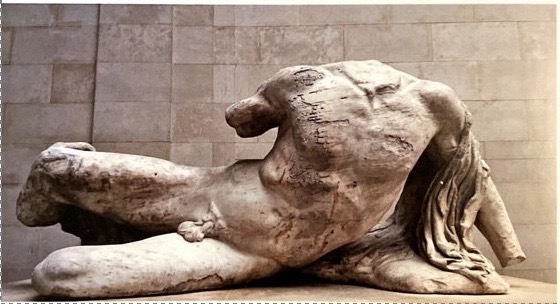
29
New cards
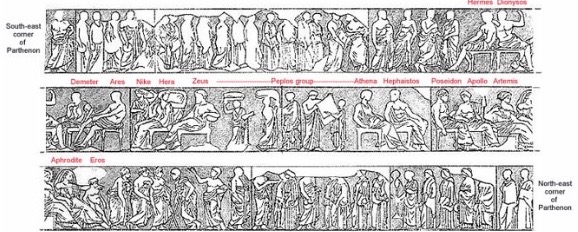
Parthenon - Ionic Frieze
* The ionic frieze dates from 442 to 437 BC
* It is made of marble
* Its narrative focuses on the Panathenaic Procession
* uniquely depicts a custom rather than a myth
* The location of the frieze as it was behind the metopes and colonnade that surrounded the temple meant that the onlookers would’ve had to strain their necks to see it
* The ionic frieze is 160 metres long and just over a meter tall
* It contains about 378 humans and divine figures and at least 220 animals
* Substantial parts of the frieze are lost
* the sculptures mimic the real-life worshippers
* Individuals on the west side are shown gathering by their horses, some are standing waiting, others are already on horseback signalling more to join
* Each figure is shown as an individual different to the others around them
* sculptors have accurately portrayed their youthful bodies and their poses are realistic depictions of movement
* horses are distinct, some are galloping, others stand calmly, others are neighing
* They have been made smaller in proportion to the men so as to leave as little space as possible
* Some men are nude some aren’t
\
* Women are also taking part in the procession
* They are fully clothed indicating their respectable and modest nature
* drapery poses are different
* While they wear a chiton covered in a himation the clothing falls differently over their bodies and the folds are neither repetitive nor symmetrical
* They each carry their own offerings or contributions to the festival
* One carries an incense burner (the first lady)
* Another carries a jug while another carries a libation bowl
* Just as the men are depicted distinctly so are the women
\
* South side of frieze sees a bull being led to sacrifice
\
* The east side of this frieze shows the climax of the festival
* In the central part of the presentation of the peplos is shown
* Framing this is he gods which sit watching the procession around them
* They have their backs turned to the central dedication which makes us question the extent to which they care about the moment but they are facing the parading worshippers
\
* It is made of marble
* Its narrative focuses on the Panathenaic Procession
* uniquely depicts a custom rather than a myth
* The location of the frieze as it was behind the metopes and colonnade that surrounded the temple meant that the onlookers would’ve had to strain their necks to see it
* The ionic frieze is 160 metres long and just over a meter tall
* It contains about 378 humans and divine figures and at least 220 animals
* Substantial parts of the frieze are lost
* the sculptures mimic the real-life worshippers
* Individuals on the west side are shown gathering by their horses, some are standing waiting, others are already on horseback signalling more to join
* Each figure is shown as an individual different to the others around them
* sculptors have accurately portrayed their youthful bodies and their poses are realistic depictions of movement
* horses are distinct, some are galloping, others stand calmly, others are neighing
* They have been made smaller in proportion to the men so as to leave as little space as possible
* Some men are nude some aren’t
\
* Women are also taking part in the procession
* They are fully clothed indicating their respectable and modest nature
* drapery poses are different
* While they wear a chiton covered in a himation the clothing falls differently over their bodies and the folds are neither repetitive nor symmetrical
* They each carry their own offerings or contributions to the festival
* One carries an incense burner (the first lady)
* Another carries a jug while another carries a libation bowl
* Just as the men are depicted distinctly so are the women
\
* South side of frieze sees a bull being led to sacrifice
\
* The east side of this frieze shows the climax of the festival
* In the central part of the presentation of the peplos is shown
* Framing this is he gods which sit watching the procession around them
* They have their backs turned to the central dedication which makes us question the extent to which they care about the moment but they are facing the parading worshippers
\
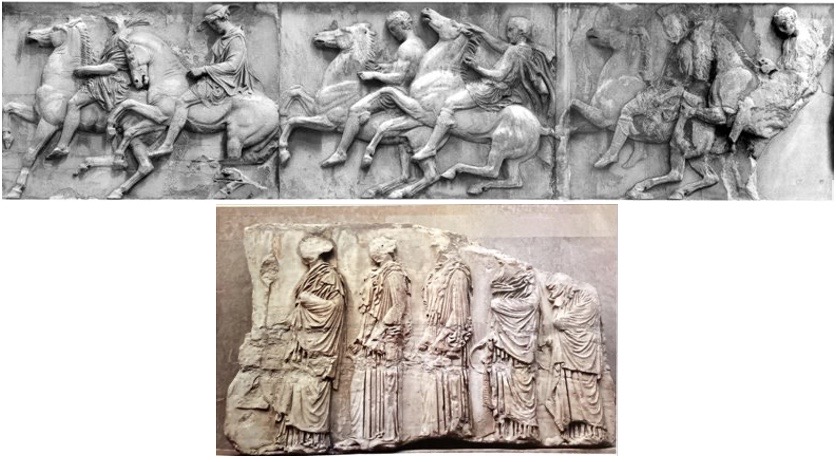
30
New cards
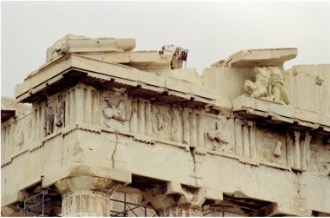
Parthenon - Metopes Context
* The metopes were sculpted between 447 and 439 BC
* All four sides of the Doric frieze were decorated with sculptures
* Each side represented a different myth each symbolising the victory of civilisation over barbarity
* Unlike the pediment on the temple of Zeus on Olympia
* These metopes show only a snapshot of the centauromachy
* The differing quality and stye of each metope reflects the involvement of different artists
* All four sides of the Doric frieze were decorated with sculptures
* Each side represented a different myth each symbolising the victory of civilisation over barbarity
* Unlike the pediment on the temple of Zeus on Olympia
* These metopes show only a snapshot of the centauromachy
* The differing quality and stye of each metope reflects the involvement of different artists
31
New cards
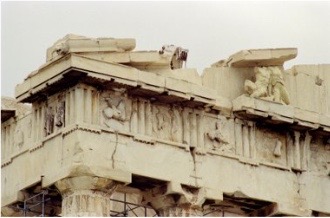
Parthenon - Metope XXVI
* Shows a lapith and a centaur mid struggle
* The lapith has raised his left leg to kick the centaur before him and his right arm is drawn back and is poised to hit the centaur on the head with a stone
* His left arm is stretched holding the centaur back to position the strike
* His weight rests on the ball of his foot indicating a spring in his attack
* His body is turned outwards so that we can see his muscular torso
* The lapith has raised his left leg to kick the centaur before him and his right arm is drawn back and is poised to hit the centaur on the head with a stone
* His left arm is stretched holding the centaur back to position the strike
* His weight rests on the ball of his foot indicating a spring in his attack
* His body is turned outwards so that we can see his muscular torso
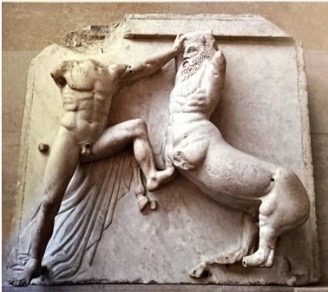
32
New cards
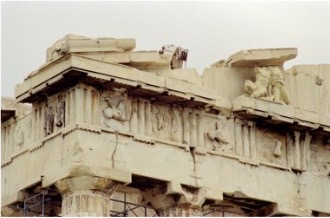
Parthenon - Metope XXVII
* The lapith and centaur open away from one another for very different reasons
* The centaur stretches out because his head is being pulled back by the lapith whereas the lapith’s open body language reflects his strength and power
* Drapery behind figures fill space
* Sculpture used the entire space of metope
* The centaur stretches out because his head is being pulled back by the lapith whereas the lapith’s open body language reflects his strength and power
* Drapery behind figures fill space
* Sculpture used the entire space of metope
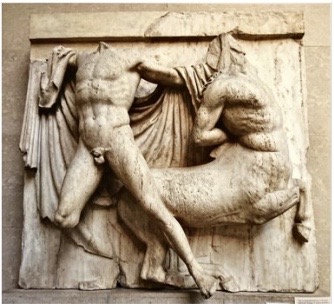
33
New cards
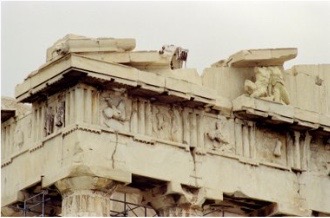
Parthenon - Metope XXVIII
* This metope depicts a very different scene from the previous two
* Instead of showing the centaur and lapith mid-fight it shows the victory of a centaur who rises above his victim
* The lapith lies contorted on the floor seemingly writhing in pain
* His legs are bent at the knee, his torso is flung upwards but his head falls to the ground clearly devoid of any further energy
* centaur holds animal skin - barbaric
* fills space with outstretched arms of centaur and lying body of Lapith, as well as animal skin covering space
* Instead of showing the centaur and lapith mid-fight it shows the victory of a centaur who rises above his victim
* The lapith lies contorted on the floor seemingly writhing in pain
* His legs are bent at the knee, his torso is flung upwards but his head falls to the ground clearly devoid of any further energy
* centaur holds animal skin - barbaric
* fills space with outstretched arms of centaur and lying body of Lapith, as well as animal skin covering space
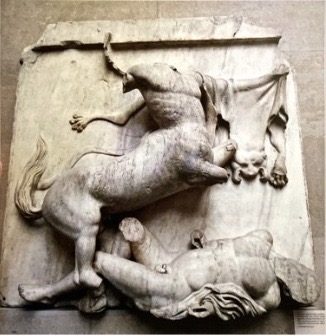
34
New cards
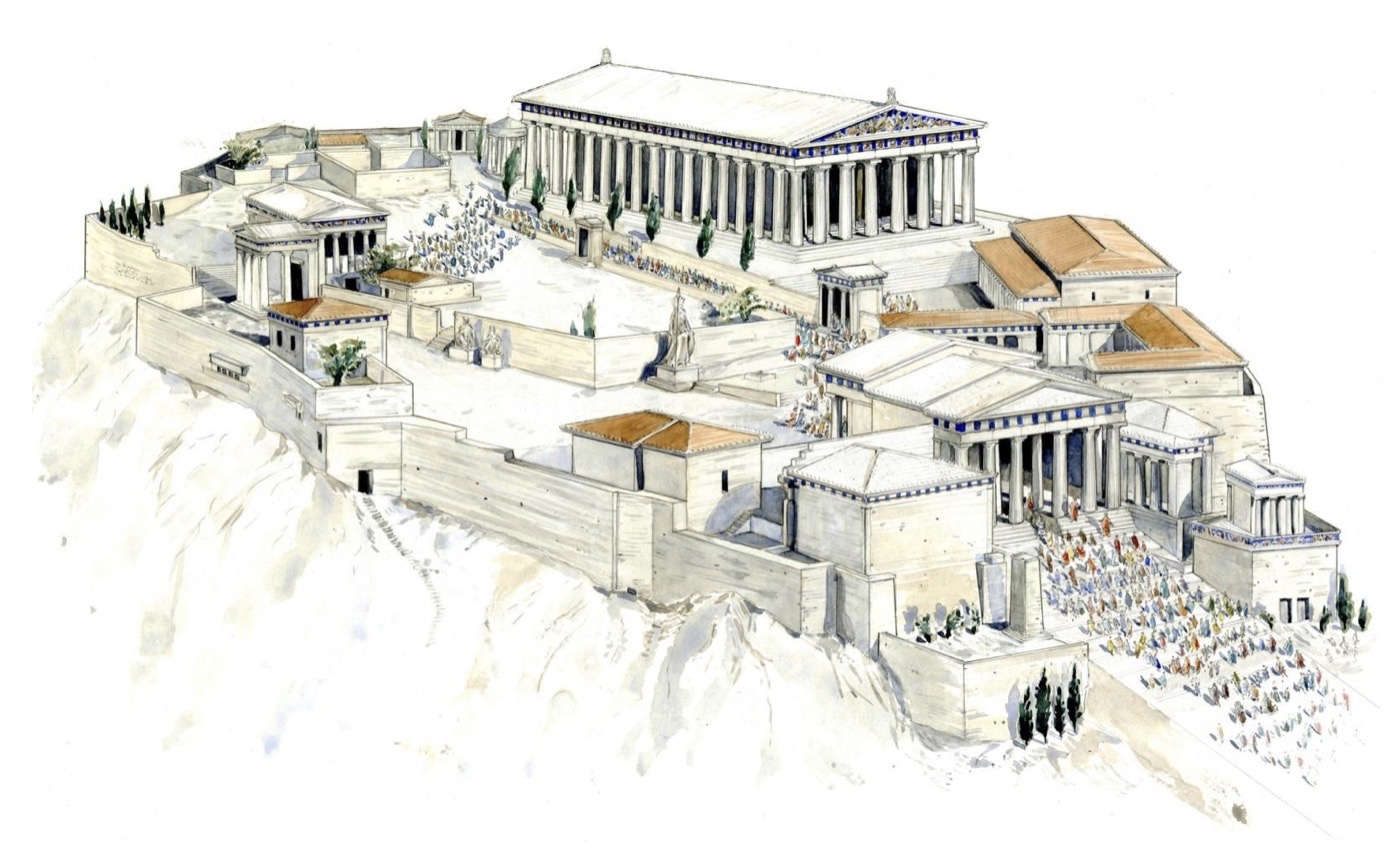
Parthenon - Scholarly Quotes
Ionic Frieze:
Woodford - ‘***The poses of the gods on the Parthenon's frieze are much more varied in comparison to the Siphnian treasury***,’
Pediments:
Dr Beth Harn - ‘***Mathematical relationship of each part of the human body to the other,***’
Woodford - (east pediment) ‘***Astonishing news of her birth carried round in waves of excitement,***’
Stuttard - (Reason for the arrangement of figures on the Parthenon's East pediment) - represents a journey from darkness into light since those associated with the Underworld are on the left and those with the world above are on the right. A re-birth (linking with Athens' post Persian wars re-birth and also mirroring the route of the Panathenaic procession)
Metopes:
Woodford - (about Metope 26) ‘***work of a less accomplished sculptor***,’
Kleiner - (Metope 28) Distinction of ‘***powerful form of the living beast from the lifeless corpse***,’
Woodford - ‘***The poses of the gods on the Parthenon's frieze are much more varied in comparison to the Siphnian treasury***,’
Pediments:
Dr Beth Harn - ‘***Mathematical relationship of each part of the human body to the other,***’
Woodford - (east pediment) ‘***Astonishing news of her birth carried round in waves of excitement,***’
Stuttard - (Reason for the arrangement of figures on the Parthenon's East pediment) - represents a journey from darkness into light since those associated with the Underworld are on the left and those with the world above are on the right. A re-birth (linking with Athens' post Persian wars re-birth and also mirroring the route of the Panathenaic procession)
Metopes:
Woodford - (about Metope 26) ‘***work of a less accomplished sculptor***,’
Kleiner - (Metope 28) Distinction of ‘***powerful form of the living beast from the lifeless corpse***,’
35
New cards
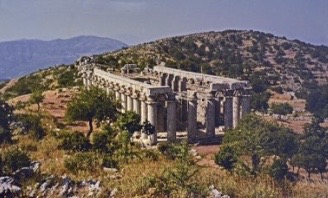
Temple of Apollo in Bassae - Context
* Built probably between the 450-425 BC
* Dedicated to Apollo following a plague
* The temple is found in a very remote mountainous location up in the hills and unfortunately little to nothing is known about who set up the temple and how they paid for it
* The temple consists of a blend of different designs
* It is also renowned for its architectural abilities
* Most relevant to its sculpture is the fact it combines 3 architectural orders
* The presence and location of the ionic frieze are particularly noteworthy as never before has sculptural decoration focused on the inside of the temple
* Dedicated to Apollo following a plague
* The temple is found in a very remote mountainous location up in the hills and unfortunately little to nothing is known about who set up the temple and how they paid for it
* The temple consists of a blend of different designs
* It is also renowned for its architectural abilities
* Most relevant to its sculpture is the fact it combines 3 architectural orders
* The presence and location of the ionic frieze are particularly noteworthy as never before has sculptural decoration focused on the inside of the temple
36
New cards
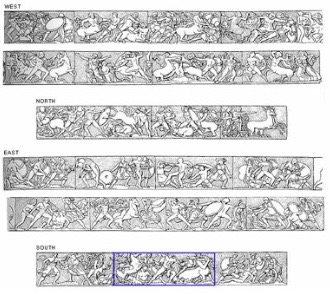
Temple of Apollo in Bassae - Ionic Frieze
General Facts:
* Built probably between the 450-425 BC
* Dedicated to Apollo following a plague
* The frieze is 3 metres in length and 0.63 metres in height
* It would’ve stood 7 metres above the ground and was carved in high relief
\
(top left of image)
* Another moment in the frieze emphasises the beastliness of the centaurs
* A feature we have seen both in Olympia and in the Parthenon metope 27
* In this scene the centaur is extended grabbing a lapith women with his right arm and punching a lapith soldier with his left
* However, the lapith may still bring his shield before him to attack
(top right of image)
* Another scene shows a centaur which has galloped over a dead centaur’s body and is biting the neck of an attacking lapith
(bottom left of image)
* This frieze shows three amazon women, each at a different stage of battle
* The one on the left is fighting off a man while the central figure is lifting and supporting a dying Amazon who lies in her arms
* Between the figures their drapery is seen billowing in the wind filling the and providing a dramatic backdrop
(bottom right of image)
* On the left side a man amazon woman prepare to fight
* To the right of the slab, an Amazon woman lies over a collapsing horse
* Built probably between the 450-425 BC
* Dedicated to Apollo following a plague
* The frieze is 3 metres in length and 0.63 metres in height
* It would’ve stood 7 metres above the ground and was carved in high relief
\
(top left of image)
* Another moment in the frieze emphasises the beastliness of the centaurs
* A feature we have seen both in Olympia and in the Parthenon metope 27
* In this scene the centaur is extended grabbing a lapith women with his right arm and punching a lapith soldier with his left
* However, the lapith may still bring his shield before him to attack
(top right of image)
* Another scene shows a centaur which has galloped over a dead centaur’s body and is biting the neck of an attacking lapith
(bottom left of image)
* This frieze shows three amazon women, each at a different stage of battle
* The one on the left is fighting off a man while the central figure is lifting and supporting a dying Amazon who lies in her arms
* Between the figures their drapery is seen billowing in the wind filling the and providing a dramatic backdrop
(bottom right of image)
* On the left side a man amazon woman prepare to fight
* To the right of the slab, an Amazon woman lies over a collapsing horse
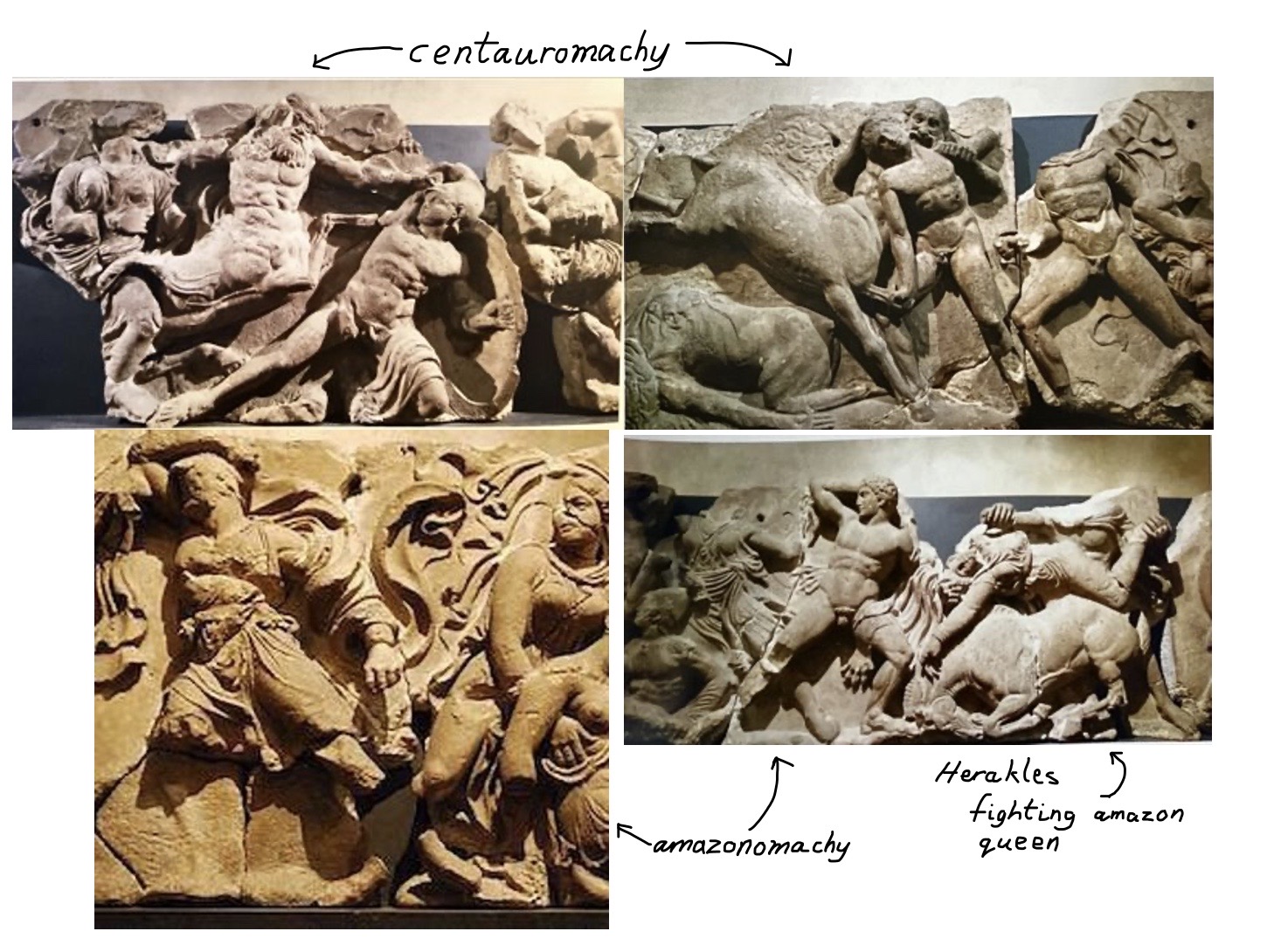
37
New cards
Temple of Apollo in Bassae - Scholarly Quotes
Sowerby - women appear **both under threat and threatening**, an **endless play of violence and heroism which allow the eyes no rest**, no hierarchy of incidents here, no single story with a beginning and end, no single focus, the frieze actively intervenes between the viewers and their worship- women flinging her arms out, appealing to us to save her
Osborne - ‘***The Parthenon frieze is a still photograph whilst the Bassae frieze is more of a movie***,’
Osborne - ‘***The Parthenon frieze is a still photograph whilst the Bassae frieze is more of a movie***,’